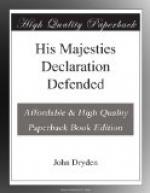Though a reaction against the Whigs was beginning, propaganda was needed to disabuse the public of two anxieties—that there was still a danger that Roman Catholicism might be restored and that the three dissolutions might foreshadow a return to unparliamentary government such as Charles I had established from 1629 to 1640, also after three dissolutions. The royal party was at first on the defensive. Their propaganda began with a proclamation issued on April 8 and ordered to be read in all churches. In the proclamation the King posed as the champion of law and order against a disloyal faction trying to overthrow the constitution. It was read in churches on April 17 and, according to Luttrell’s Brief Historical Relation (I, 77), “in many places was not very pleasing, but afforded matter of sport to some persons.” Among several replies was one entitled A Letter from a Person of Quality to his Friend. Clearly there was need to answer this pamphlet and to state more fully the case against the Whigs. This task was undertaken by two of the greatest writers of English prose—George Savile, then Earl, later Marquis of Halifax, and John Dryden. Halifax, in the tract lately identified as his by Hugh Macdonald (Cambridge, 1940), Observations upon a late Libel—though he might scarify an individual opponent like Shaftesbury or pour ridicule upon a sentence from A Letter, set himself the task of answering the Whig case as a whole. The text he dilated upon was: “there seemeth to be no other Rule allowed by one sort of Men, than that they cannot Err, and the King cannot be in the Right.” With superb irony and wit he demonstrated how inconsistent such an attitude was with the constitution of that day.
Dryden’s tract, His Majesties Declaration Defended is, like the one he is answering, in the form of a letter to a friend who has asked the writer’s opinion of the Declaration and the answer to it. “I shall obey you the more willingly,” Dryden responds, “because I know you are a lover of the Peace and Quietness of your Country; which the Author of this seditious Pamphlet, is endeavouring to disturb.” He writes to show the “goodness and equity” of the Prince, because once they are understood, the faction will lose its power and the well-meaning but misled crowd will be no longer deceived by “the




